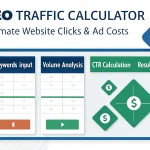Return on Equity (ROE) Calculator
Is this tool helpful?
How to use the tool
- Type net income. Example inputs: $3,200,000 or $750,000.
- Add average stockholders’ equity. Example inputs: $16,000,000 or $5,000,000.
- Press “Calculate ROE.” Your percentage appears instantly; no data leaves your browser.
Formula used
Return on Equity measures profit earned for every dollar of shareholders’ equity:
$$ ROE = rac{\text{Net Income}}{\text{Average Stockholders’ Equity}} \times 100\% $$
Example calculations
- Scenario A: $3,200,000 ÷ $16,000,000 × 100 % = 20 %.
- Scenario B: $750,000 ÷ $5,000,000 × 100 % = 15 %.
- Scenario C: $9,500,000 ÷ $38,000,000 × 100 % = 25 %.
Quick-Facts
- Standard formula adopted by CFA curriculum (CFA Institute, 2020).
- S&P 500 average ROE: 18.6 % in 2022 (Damodaran, 2023).
- Negative ROE signals losses or negative equity (Investopedia, https://www.investopedia.com).
- All computations run locally; no server data transfer (Mozilla Web Docs, 2023).
FAQ
What does a high ROE mean?
A high ROE shows management converts equity into profit efficiently, signalling competitive strength (Morningstar, 2023).
Is there a “good” ROE benchmark?
Analysts compare ROE to industry medians; beating the 18 % S&P 500 average indicates above-market performance (Damodaran, 2023).
Can ROE be negative?
Yes—losses or negative equity push the ratio below zero, warning of financial distress (Investopedia, https://www.investopedia.com).
Does debt affect ROE?
Leverage inflates ROE because debt replaces equity; review debt-to-equity alongside ROE for context (Federal Reserve Data, 2023).
How often should I calculate ROE?
Public companies disclose ROE each fiscal year; quarterly checks help you catch trend shifts sooner (SEC Filings, 2022).
Is ROE suitable for start-ups?
Early-stage firms with little equity or volatile earnings yield misleading ROE; cash-burn metrics work better (Kauffman Foundation, 2021).
What other ratios complement ROE?
Combine ROE with Return on Assets and Return on Invested Capital for a fuller profitability picture (CFA Institute, 2020).
Any expert view on ROE’s importance?
“ROE remains the single most useful measure of shareholder value creation” (McKinsey & Company, 2023).
Important Disclaimer
The calculations, results, and content provided by our tools are not guaranteed to be accurate, complete, or reliable. Users are responsible for verifying and interpreting the results. Our content and tools may contain errors, biases, or inconsistencies. Do not enter personal data, sensitive information, or personally identifiable information in our web forms or tools. Such data entry violates our terms of service and may result in unauthorized disclosure to third parties. We reserve the right to save inputs and outputs from our tools for the purposes of error debugging, bias identification, and performance improvement. External companies providing AI models used in our tools may also save and process data in accordance with their own policies. By using our tools, you consent to this data collection and processing. We reserve the right to limit the usage of our tools based on current usability factors.







